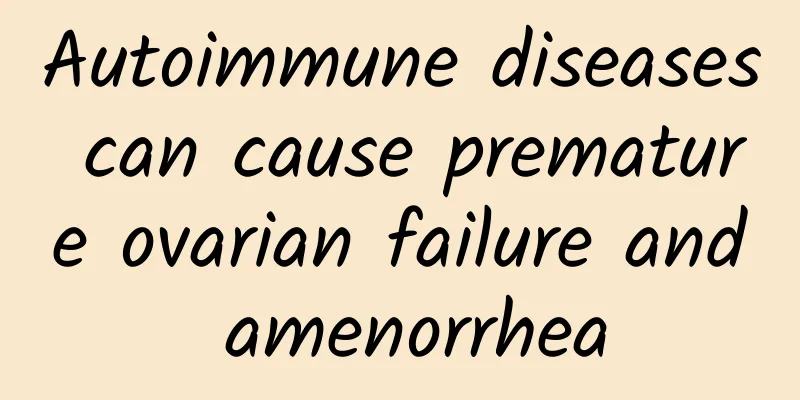Autoimmune diseases can cause premature ovarian failure and amenorrhea

|
Premature ovarian failure amenorrhea refers to secondary amenorrhea that occurs between the age of 35 and after menarche, and some argue that it occurs at any age between the age of 40 and is characterized by high gonadotropin and low estrogen, and ovarian histology shows changes in the perimenopause or postmenopause of elderly women. Patients with premature ovarian failure have unilateral gonadal dysgenesis. The first clinical manifestation is menstrual changes. Generally, after normal puberty sexual development, menstrual disorders or progressive oligomenorrhea appear, and then amenorrhea occurs. The typical symptoms of hot flashes and flushing are the only clues to the diagnosis. A variety of autoimmune diseases can cause premature ovarian failure. The most common is autoimmune thyroiditis, which is also seen in parathyroid/adrenalitis and polyglandular syndrome involving the above glands at the same time. Rare cases include myasthenia gravis, sudden thrombocytopenic purpura, rheumatoid arthritis, vitiligo and autoimmune hemolytic anemia. There are a variety of organ-specific autoimmune antibodies in the circulation, such as antibodies to the thyroid (anti-thyroglobulin and anti-microsomal antibodies), gastric parietal cells, adrenal cortex and parathyroid glands. It has been proven that these antibodies also act on follicular cells; a few reports only detected ovarian autoantibodies, but not other antibodies. Immunofluorescence showed that the antibody binds to the granulosa cells and theca cells of the follicles. It was also found that there are immunoglobulins in the serum that inhibit the binding of FSH (follicle stimulating hormone secreted by the pituitary gland) receptors. Lymphocyte infiltration in ovarian biopsy specimens is a histological feature of autoimmune oophoritis, and plasma cell nests may or may not be present; there are reports that the number of oocytes is reduced or absent due to the influence of autoimmunity, and occasionally the gonads are cord-like, with only interstitium and complete absence of primordial follicles. |
<<: Some obvious clinical symptoms of early vulvar leukoplakia
>>: Is it necessary to induce ovulation in adolescent functional uterine bleeding?
Recommend
What to do if you have pelvic effusion and cervicitis
Gynecological diseases are a major problem that t...
What are the examination methods for vaginitis
Vaginitis is generally easier to cure in its earl...
Three principles of slimming and light eating: vegetable soup helps lose weight
With the arrival of spring, it’s time to get rid ...
Is it better to relieve dysmenorrhea or diet therapy?
Dysmenorrhea is something that most women have to...
What are the diagnostic criteria for pelvic peritonitis?
A disease that is easily induced by female friend...
How to confirm that it is ovulation bleeding?
How to confirm that it is ovulation bleeding? Ovu...
Overview of Hyperprolactinemia
Hyperprolactinemia, also known as hyperprolactine...
Can I get pregnant with ovarian cysts? What are the symptoms?
Can I get pregnant with ovarian cysts? What are t...
If you want to lose weight by reducing sugar, is it enough to just eat less sugar? Japanese diabetes doctor: Supplementing more protein and iron is effective
Sugar-reducing diets have become quite popular in...
Simply shake off the oil! 3 tips to turn a lazy woman into a lazy beauty!
Eating hotpot is the most comfortable thing, but ...
What are the common treatments for ectopic pregnancy?
The treatment of ectopic pregnancy generally requ...
What should I pay attention to if I have cervical warts?
Cervical warts are a common skin disease. The occ...
Early treatment costs for cervical warts
Nowadays people are troubled by many diseases. Ce...
Do you know the causes of adnexitis?
What causes adnexitis? Experts say: Among inflamm...
Are there any side effects of amenorrhea medication?
As we all know, regular menstruation is very impo...









